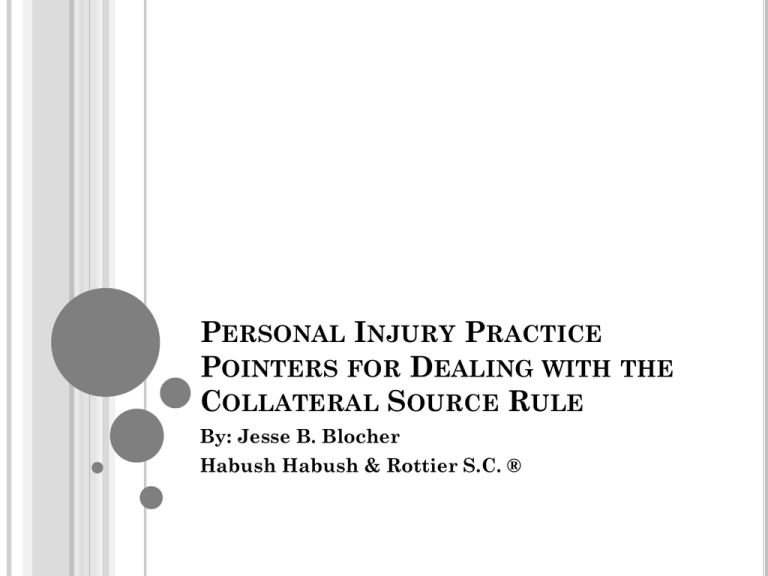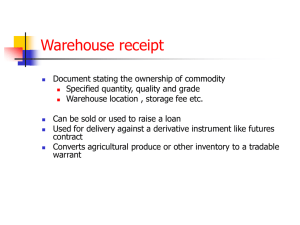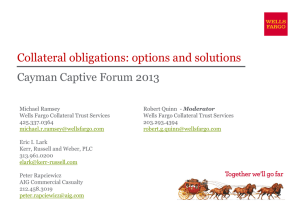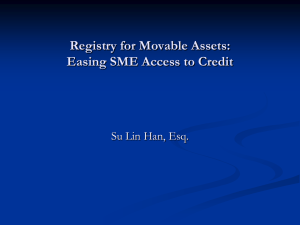Personal Injury Practice Pointers for Dealing
advertisement

PERSONAL INJURY PRACTICE POINTERS FOR DEALING WITH THE COLLATERAL SOURCE RULE By: Jesse B. Blocher Habush Habush & Rottier S.C. ® WHAT IS THE COLLATERAL SOURCE RULE? “The collateral-source rule provides that the damages to be awarded to an injured person are not to be affected by the fact that the claimant received compensation from other sources, such as sick leave, compensation, or insurance.” Payne v. Bilco Co., 54 Wis. 2d 424, 433, 195 N.W.2d 641, 647 (1972). WHAT IS THE COLLATERAL SOURCE RULE? Example, lost wages: Employee is injured in a car accident due to the fault of Bad Driver and must miss a month of work. Employee sustained a loss of earning capacity Employee is entitled to claim what he was “reasonably capable of earning at his usual trade or occupation during such period as he was unable to perform his usual work or carry on his usual occupation as a natural consequence of the personal injuries.” Payne v. Bilco Co., 54 Wis. 2d 424, 434, 195 N.W.2d 641, 647 (1972) The benevolent employer of Employee decides to continue his wages during the time Employee is off work. Bad Driver must still compensate Employee for his missed wages during that month based on the collateral source rule. Id. WHAT IS THE PURPOSE OF THE COLLATERAL SOURCE RULE? Defendants often bemoan the collateral source rule as creating a windfall or double recovery for the plaintiff. So why does it exist? “Our tort law applies the collateral source rule as part of a policy seeking to ‘deter negligent conduct by placing the full cost of the wrongful conduct on the tortfeasor.’ The tortfeasor who is legally responsible for causing injury is not relieved of his obligation to the victim simply because the victim had the foresight to arrange, or good fortune to receive, benefits from a collateral source for injuries and expenses. In an early case applying the collateral source rule to wages this court stated: We see no reason why one whose acts have caused injury to another should reap the entire benefit that comes from the payment of wages made by an employer, either as a gratuity to a faithful employee or because such payments are required by contract. Such payments do not change the nature of the injury which the employee sustains through the wrongful acts of the tortfeasor. If either is to profit by the payments made by the employer, it should be the person who has been injured, not the one whose wrongful acts caused the injury. The extent of the liability of the wrongdoer is dependent upon the extent of the injuries inflicted by his wrongful act, not upon the question whether the employee receives wages during disability from his employer.” Ellsworth v. Schelbrock, 2000 WI 63, ¶ 7, 235 Wis. 2d 678, 684-85, 611 N.W.2d 764, 767, (internal citations omitted). Creates a uniform measure of damages in all cases. If there is to be any double recovery, the rule benefits the plaintiff rather than the tortfeasor as a matter of equity. Prevents loss associated with paying insurance premiums by insured plaintiff. HOW DOES THE COLLATERAL SOURCE RULE AFFECT MOST PERSONAL INJURY CASES? Most common application is determining the “reasonable value” of medical expenses. However, it also applies to other benefits such as disability payments. See Betterman v. Fleming Companies, Inc., 2004 WI App 44, ¶ 34, 271 Wis. 2d 193, 212, 677 N.W.2d 673, 682. See also Ellsworth v. Schelbrock, 2000 WI 63, ¶ 8, 235 Wis. 2d 678, 685, 611 N.W.2d 764, 767 (citing Restatement (Second) of Torts § 920A cmt. c (1979)) (“it is the tortfeasor's responsibility to compensate for all harm that he [or she] causes, not confined to the net loss that the injured party receives. . . . [T]he collateral source rule applies to benefits from insurance policies, gratuities, and benefits from employment and social legislation.”) THE “REASONABLE VALUE” OF MEDICAL EXPENSES “In Wisconsin, a plaintiff who has been injured by the tortious conduct of another may recover the reasonable value of medical services rendered.” Koffman v. Leichtfuss, 2001 WI 111, ¶ 27, 246 Wis. 2d 31, 46, 630 N.W.2d 201, 209. THE “REASONABLE VALUE” OF MEDICAL EXPENSES “Where the plaintiff's health care providers settle the plaintiff's medical bills with the plaintiff's insurers at reduced rates, the collateral source rule dictates that the defendant-tortfeasor not receive the benefit of the written-off amounts. the benefit of the reduced payments inures solely to the plaintiff.” Koffman v. Leichtfuss, 2001 WI 111, ¶ 30, 246 Wis. 2d 31, 48-49, 630 N.W.2d 201, 210. THE “REASONABLE VALUE” OF MEDICAL EXPENSES “. . . [W]here the costs of plaintiff's medical treatment have been paid by a health care insurer, the three principles co-exist and operate in the following fashion: (1) the plaintiff is entitled to seek recovery for the reasonable value of medical services rendered in treating the claimed injury; (2) the collateral source rule allows the plaintiff to seek recovery for the reasonable value of medical services without consideration of payments made by the plaintiff's insurer; and (3) the insurer's subrogation rights entitle it to recoup the amounts it paid on the plaintiff's behalf.”Koffman v. Leichtfuss, 2001 WI 111, ¶ 46, 246 Wis. 2d 31, 54, 630 N.W.2d 201, 213. THE “REASONABLE VALUE” OF MEDICAL EXPENSES Example: Plaintiff is injured in an accident due to Bad Driver’s negligence and incurs a $10,000 doctor bill, which is a reasonable amount for practitioners in the area. Plaintiff’s health insurer pays $5,000 and physician writes off $5,000 pursuant to a negotiated volume contractual discount. Plaintiff is entitled to recover entire $10,000 less health insurer’s $5,000 subrogated interest. INSURERS’ FAILED ATTEMPTS TO AVOID THE COLLATERAL SOURCE RULE In Koffman, the insurer argued that because the plaintiff’’s insurers were subrogated to his claim, plaintiff had no right to recover full amount of medical expenses, only subrogated parties could recover the discounted amount they paid. What is subrogation? “The interaction of the collateral source rule with the third legal principle implicated today, subrogation, has engendered the confusion that has arisen in the case at hand. By virtue and to the extent of payments made on behalf of another, a subrogated party obtains a right of recovery in an action against a third-party tortfeasor and is a necessary party in an action against such a tortfeasor. Subrogation exists to ensure that the loss is ultimately placed upon the wrongdoer and to prevent the subrogor from being unjustly enriched through a double recovery, i.e., a recovery from the subrogated party and the liable third party.” Koffman v. Leichtfuss, 2001 WI 111, ¶ 33, 246 Wis. 2d 31, 50, 630 N.W.2d 201, 210-11 (internal citations omitted). INSURERS’ FAILED ATTEMPTS TO AVOID THE COLLATERAL SOURCE RULE Koffman court rejected that argument: “Applying the collateral source rule to payments that have been reduced by contractual arrangements between insurers and health care providers assures that the liability of similarly situated defendants is not dependent on the relative fortuity of the manner in which each plaintiff's medical expenses are financed. One plaintiff may be uninsured and receive the benefit of Medical Assistance, another's insurer may have paid full value for the treatment, and yet another's insurer may have received the benefit of reduced contractual rates. Despite the various insurance arrangements that exist in each case, the factor controlling a defendant's liability for medical expenses is the reasonable value of the treatment rendered.” Koffman v. Leichtfuss, 2001 WI 111, ¶ 31, 246 Wis. 2d 31, 49, 630 N.W.2d 201, 210. “It is undisputed that the plaintiff's insurers have valid subrogation interests that they have asserted and pursued in this action. However, the consequence of those subrogation rights is in dispute. The defendants assert that the insurers' subrogation rights limit the recoverable medical expense damages to the amounts actually paid. We do not find the insurers' subrogation interests to have such an effect.” Id. ¶ 34. INSURERS’ FAILED ATTEMPTS TO AVOID THE COLLATERAL SOURCE RULE “Contrary to the defendant's assertions, the payments made on the insured's behalf define only the insurers' subrogation interest in the medical expense claim. The claim of medical expense damages as a whole is defined by the reasonable value of the services rendered as a result of the tortfeasor's negligent conduct. The creation of a subrogation interest in an insurer does not change the nature of the entire claim for medical expense damages. Thus, recoverable medical expense damages may exist beyond that of the amount paid by the insurer, and the insured is entitled to pursue those amounts.” Koffman v. Leichtfuss, 2001 WI 111, ¶ 45, 246 Wis. 2d 31, 54, 630 N.W.2d 201, 212-13 (internal citations omitted). INSURERS’ FAILED ATTEMPTS TO AVOID THE COLLATERAL SOURCE RULE The insurer in Ellsworth argued that Medicaid benefits should not be subject to the collateral source rule because the taxpayer, not the plaintiff paid for the Medicaid coverage. Court rejected that argument: “In keeping with precedent and well-established tort policy, we conclude that the collateral source rule applies to Medical Assistance benefits. The injured party may establish and recover the reasonable value of the medical services received gratuitously via Medical Assistance. The state's subrogated amount is deducted from this recovery, and the injured party is entitled to any remainder.” Ellsworth v. Schelbrock, 2000 WI 63, ¶ 22, 235 Wis. 2d 678, 693, 611 N.W.2d 764, 771. INSURERS’ FAILED ATTEMPTS TO AVOID THE COLLATERAL SOURCE RULE The Court also rejected the insurer’s argument that even though the plaintiff is not strictly limited to recovery of the subrogated amount, the subrogated payment can serve as evidence of the reasonable value of medical expenses: “. . .[B]oth Koffman and Ellsworth recognize that while a health insurance provider may negotiate discounted rates with a health care provider, that negotiated rate is not evidence of the reasonable value of those medical services for purposes of determining damages in a tort claim. Consequently, a defendant must produce some competent evidence other than what the insurance company paid upon which to base its argument that the amount billed was not the reasonable value of the services. . . . For instance, [the defendant] could have offered expert testimony as to the reasonable value of the medical services provided in support of its argument that the amount billed for the medical services was not the reasonable value of the services. Instead, it chose to rely solely on its assertion that the actual amount paid by an insurance company is admissible evidence of reasonable value. For the reasons already explained, we reject that assertion. . . . We conclude that the collateral source rule prohibits defendants in a personal injury case from introducing evidence of the amount of medical expenses actually paid for the purpose of showing that the billed expenses were not reasonable.” Leitinger v. Van Buren Mgmt., Inc., 2006 WI App 146, ¶¶ 1819, 295 Wis. 2d 372, 382, 720 N.W.2d 152, 157-58 aff'd sub nom. Leitinger v. DBart, Inc., 2007 WI 84, 302 Wis. 2d 110, 736 N.W.2d 1. THE STATUTORY PRESUMPTION So we know what is not “reasonable,” what is “reasonable”? The “reasonable value” of the medical expenses is presumptively proved by the amount billed by the physician. Wisconsin Statutes § 908.03(6m)(bm) states: “(bm) Presumption. Billing statements or invoices that are patient health care records are presumed to state the reasonable value of the health care services provided and the health care services provided are presumed to be reasonable and necessary to the care of the patient. Any party attempting to rebut the presumption of the reasonable value of the health care services provided may not present evidence of payments made or benefits conferred by collateral sources.” PRACTICE POINTERS –INTRODUCING MEDICAL BILLS AS PROOF OF THE “REASONABLE VALUE” OF MEDICAL EXPENSES In litigation, make sure you can lay the foundation for admission of the records at trial: First, with respect to the presumption, the plaintiff as proponent of the evidence of medical expenses has the burden of production and persuasion as to the basic facts. If the proponent meets these burdens, the defendant then has the burden of production and persuasion to prove the nonexistence of the presumed facts. Wis. Stat. § 903.01; See Blinka, Wisconsin Evidence 3rd, § 401.10 (2011 supplement). Plaintiff must prove the basic facts that the documents are “billing statements” and are “patient health care records.” PRACTICE POINTERS –INTRODUCING MEDICAL BILLS AS PROOF OF THE “REASONABLE VALUE” OF MEDICAL EXPENSES What are “patient health care records?” Wisconsin Statutes § 908.03(6m)(a)1 incorporates the definition from § 146.81(4), which states: “‘Patient health care records’ means all records related to the health of a patient prepared by or under the supervision of a health care provider; and all records made by an ambulance service provider, as defined in s. 256.01(3), an emergency medical technician, as defined in s. 256.01(5), or a first responder, as defined in s. 256.01(9), in administering emergency care procedures to and handling and transporting sick, disabled, or injured individuals. ‘Patient health care records’ includes billing statements and invoices for treatment or services provided by a health care provider and includes health summary forms prepared under s. 302.388(2). “Patient health care records” does not include those records subject to s. 51.30, reports collected under s. 69.186, records of tests administered under s. 252.15 (5g) or (5j), 343.305, 938.296(4) or (5) or 968.38(4) or (5), records related to sales of pseudoephedrine products, as defined in s. 961.01(20c), that are maintained by pharmacies under s. 961.235, fetal monitor tracings, as defined under s. 146.817(1), or a pupil's physical health records maintained by a school under s. 118.125.” The Court in Correa v. Farmers Ins. Exch., 2010 WI App 171, ¶ 7, 330 Wis. 2d 682, 688, 794 N.W.2d 259, 262 found that “patient health care records” included physician billing statements, ambulance billing statements, but remanded for a determination as to whether a certin corporations records were “ prepared by or under the supervision of a health care provider.” PRACTICE POINTERS –INTRODUCING MEDICAL BILLS AS PROOF OF THE “REASONABLE VALUE” OF MEDICAL EXPENSES What are “billing statements”? The Court found that a medical charge summary prepared by the health care provider was a “billing statement”, Medicaid claim forms were not “billing statements.” Correa v. Farmers Ins. Exch., 2010 WI App 171, ¶ 7, 330 Wis. 2d 682, 688, 794 N.W.2d 259, 262. So based on Correa, don’t need the original bill to the insurer or patient, but you need at least a billing summary or itemization prepared by the “health care provider” to meet burden on the basic facts. PRACTICE POINTERS –INTRODUCING MEDICAL BILLS AS PROOF OF THE “REASONABLE VALUE” OF MEDICAL EXPENSES Second, how to introduce and authenticate the bills at trial Pursuant to § 908.03(6m)(b) authenticating witness is unnecessary to introduce the billing statements if the following is done: “A custodian or other qualified witness required by sub. (6) is unnecessary if the party who intends to offer patient health care records into evidence at a trial or hearing does one of the following at least 40 days before the trial or hearing: 1. Serves upon all appearing parties an accurate, legible and complete duplicate of the patient health care records for a stated period certified by the record custodian. 2. Notifies all appearing parties that an accurate, legible and complete duplicate of the patient health care records for a stated period certified by the record custodian is available for inspection and copying during reasonable business hours at a specified location within the county in which the trial or hearing will be held.” PRACTICE POINTERS –INTRODUCING MEDICAL BILLS AS PROOF OF THE “REASONABLE VALUE” OF MEDICAL EXPENSES What must the defense do to overcome the presumption? Introduce qualified expert testimony – not based on the amount of the subrogated payment – that the billing charge is unreasonable. Leitinger v. Van Buren Mgmt., Inc., 2006 WI App 146, ¶¶ 18-19, 295 Wis. 2d 372, 382, 720 N.W.2d 152, 157-58. If the defense does that, the plaintiff should consider whether expert testimony is necessary to maintain the credibility of the claim for the “reasonable value” of medical expenses. Be careful about using the treating physician to support the reasonableness of medical expenses if disputed because the treating physician will have very little foundation and knowledge about billing rates in the area and may only be able to respond with a cursory “of course the amount I bill is reasonable.” PRACTICE POINTERS –INTRODUCING MEDICAL BILLS AS PROOF OF THE “REASONABLE VALUE” OF MEDICAL EXPENSES Practically, how can you ensure that there will be no issues at the time of trial – or at least discover what the defense is disputing and why? Use requests for admissions to “conclusively establish” the basic facts and authenticate the document. Wis. Stat. § 804.11. In most cases, the defendant insurers will not want to spend the time an money to battle over the “reasonable” value of medical expenses. Requests for admissions “conclusively establish” that “reasonableness” will not be an issue, and if it is, request by interrogatory all evidence supporting the denial. PRACTICE POINTERS – USING THE COLLATERAL SOURCE RULE PRE-SUIT For most PI lawyers, most claims never see a courtroom, but collateral source rule is one of the most important rules to be aware of to advise your clients. Why? Get the client the best possible result. PRACTICE POINTERS – USING THE COLLATERAL SOURCE RULE PRE-SUIT Example: Client has a PI claim worth $30,000. Medical Expenses total $15,000; pain and suffering $15,000. Client has three options for immediate payment of medical expenses: (1) not pay and wait for liability settlement, (2) use health insurance, (3) use medical payments coverage from automobile insurance policy. Which should client choose? PRACTICE POINTERS – USING THE COLLATERAL SOURCE RULE PRE-SUIT What is wrong with leaving bill outstanding? Client could be sent to collections, unless agreement is made with provider. Eventually client will have to pay the full amount of the bill to the provider unless a discount can be directly negotiated. If a lawsuit if filed, the outstanding balance may undermine the physician’s credibility because the physician will not have a financial interest in the outcome of the case. If client loses, timely filing of health insurance claim period will have passed and client will be stuck with the bill. PRACTICE POINTERS – USING THE COLLATERAL SOURCE RULE PRE-SUIT What is wrong with using medical payments coverage though client’s automobile policy? Limited amount of coverage. Long wait for coverage determination in disputed cases could send your client’s bill to collection. No discount arrangement with provider. Some carriers are not agreeing to pay the full bill because charge is unreasonable as defined in the policy and there is no contract with the provider to force the provider to take less. PRACTICE POINTERS – USING THE COLLATERAL SOURCE RULE PRE-SUIT In most cases it will be best to use the client’s health insurance. Covers everything in the event of a dispute. Provider must accept the contractual discount in most cases. Provider must work directly with insurer and usually cannot bill client for denied or reduced charges. If client has annual deductibles or out-of-pocket maximums, using health insurance as primary (and auto med pay as secondary) maximizes the insurance benefit. PRACTICE POINTERS – USING THE COLLATERAL SOURCE RULE PRE-SUIT It also maximizes client’s benefit from the claim: Assuming liability insurer agrees to pay full value of $30,000 and assuming a 50% contractual discount from the health insurer, and a 1/3 contingency fee for attorney, client’s settlement would break down as follows if health insurance is used: $30,000 total settlement Less $10,000 for attorneys fees Less $7,500 repayment to subrogated health insurer Client nets: $12,500 PRACTICE POINTERS – USING THE COLLATERAL SOURCE RULE PRE-SUIT On the contrary, if medical payments coverage is used as primary or if bills are outstanding, the settlement breaks down as follows: $30,000 total settlement Less $10,000 for attorneys fees Less $15,000 repayment to subrogated health insurer Client nets: $5,000 So taking advantage of the client’s payment arrangements from collateral sources helps to maximize the result. Probably a good idea if you get the case early enough to help the client understand the benefits of using the health insurance discount and being proactive with providers to make sure they are processing the bills correctly and adhering to their contractual obligations. There are exceptions in some cases where by law providers have a lien, or the health insurer is secondary by law or the terms of its policy – so you have to be careful of that. EXCEPTIONS – THE LAMBERT/OTTO RULE “[S]ince the doctrine of subrogation was designed in part to prevent double recovery by the Plaintiff, the Plaintiff should not be allowed to recover the full amount free of the subrogation claim of the insurer which was extinguished by the running of the statute of limitations against the subrogated insurer.” Lambert v. Wrensch, 135 Wis. 2d 105, 119, 399 N.W.2d 369, 375 (1987) (internal citations omitted). “Ordinarily, subrogation and the collateral source rule work together. Subrogation prevents double recovery by a plaintiff while the collateral source rule prevents payments made by an insurer from benefiting the defendant. However, ‘where the insurer is barred from pursuing a claim [of subrogation], the tortfeasor is entitled to a reduction in judgment for the amount of that claim.’ In such a situation, the risk of double recovery by the plaintiff, from both the insurer and the tortfeasor for the same injury, defeats the collateral source rule. Indeed, Wisconsin courts recognize a plaintiff should be made whole, but no more than whole. Otto contends, however, that unlike those prior cases, particularly Lambert, Blue Cross lost its subrogation right through a default judgment, not the running of the statute of limitations. Therefore, it asserts the rule from Lambert, as discussed in Koffman, should not apply. We decline to address this argument. Rather, we note that at the time judgment was entered against PIC, the statute of limitations had run on Blue Cross's subrogation claim. We therefore hold that when judgment is entered against a tortfeasor, if a concomitant subrogation claim is time-barred because the statute of limitations has run, theLambert-Koffman rule applies to invalidate the collateral source rule. Thus, PIC is entitled to an offset for the subrogated amount.” Estate of Otto v. Physicians Ins. Co. of Wisconsin, Inc., 2007 WI App 192, ¶¶ 31, 32, 305 Wis. 2d 198, 214-16, 738 N.W.2d 599, 607-08 aff'd, 2008 WI 78, 311 Wis. 2d 84, 751 N.W.2d 805. EXCEPTIONS – THE LAMBERT/OTTO RULE The Lambert rule is narrowly limited to situations where the subrogated entity is time-barred by the statute of limitations from pursuing its claim: “The Lambert decision also contains language that might suggest that the collateral source rule is wholly inapplicable where an insurer has a subrogated interest. Id. at 121, 399 N.W.2d 369. Indeed, such a characterization of the Lambert decision was repeated in Ellsworth, 2000 WI 63 at ¶ 18, 235 Wis.2d 678, 611 N.W.2d 764. Focusing upon this language in Lambert, the defendant argues that the circuit court correctly determined that the insurers' subrogation rights rendered the collateral source rule inapplicable in the case at hand. Lambert should not be read so broadly. The language of Lambert suggests that the holding is limited to its facts. Lambert, 135 Wis.2d at 121, 399 N.W.2d 369 (“[W]here subrogation is present, as here, the collateral source rule is inapplicable.” (emphasis added)). In Voge v. Anderson, we properly characterized Lambert as holding that “where the insurer is barred from pursuing a claim [of subrogation], the tortfeasor is entitled to a reduction in judgment for the amount of that claim.” 181 Wis.2d 726, 732, 512 N.W.2d 749 (1994); see also Jindra v. Diederich Flooring, 181 Wis.2d 579, 596, 511 N.W.2d 855 (1994) (describing “narrow situation” of Heifetz and Lambert); Petry v. St. Paul Fire & Marine Ins., 151 Wis.2d 343, 346, 444 N.W.2d 428 (Ct.App.1989). Consistent with this narrow reading of Lambert, we now clarify that where, as here, the risk for double recovery on the part of the plaintiff-insured does not exist because the insurer is not barred from pursuing its subrogation rights, there is no justification for nullifying the collateral source rule. In the ordinary case, the collateral source rule and the principles of subrogation work in tandem to further the goals of both rules. The collateral source rule prevents payments made by the insured from inuring to the benefit of the defendant, and the insurer's subrogation rights prevent a double recovery on the part of the plaintiff Moreover, we note that even if this case did present us with a Lambert situation (where the insurer is barred from pursuing its subrogation rights), reliance on Lambert to limit the defendants' liability to the amount paid would be misplaced. If the rule of Lambert were applicable in this case, the effect would not be to limit the medical expense damages to the amounts paid. Rather, if the insurer is barred from exercising its subrogation rights, the plaintiff's recovery of the reasonable value of medical expenses would simply be reduced by the amounts paid on his behalf in order to prevent a double recovery.” Koffman v. Leichtfuss, 2001 WI 111, ¶¶ 37-41, 246 Wis. 2d 31, 52-53, 630 N.W.2d 201, 212 (emphasis added). EXCEPTIONS – THE LAMBERT/OTTO RULE Although there is some ambiguity, the caselaw supports the argument that where the subrogated entity waives its interest, the plaintiff can still apply the collateral source rule and claim that amount. “We conclude that medical expenses paid by an insurer are properly awarded where the insurer either waives or properly exercises its subrogation rights. We remand on this issue, with directions that the trial court reinstate the original jury award of $10,000 for medical expenses.” Anderson v. Garber, 160 Wis. 2d 389, 402, 466 N.W.2d 221, 226 (Ct. App. 1991). “Insurers may waive their subrogation rights, and when they do so, the collateral source rule applies.” Blumenfeld v. Jeans, 2011 WI App 107, ¶ 6, 336 Wis. 2d 430, 435, 804 N.W.2d 692, 695. UM/UIM Special Rule for UM/UIM cases? For a long time we lived with the Graser rule: “[T]he collateral source rule, which finds its genesis in tort law, is inapplicable to claims made by an insured under his or her UIM policy.” Heritage Mut. Ins. Co. v. Graser, 2002 WI App 125, ¶ 1, 254 Wis. 2d 851, 854, 647 N.W.2d 385, 386. UM/UIM In 2012, the Wisconsin Supreme Court overturned Graser: “We reaffirm what our prior precedent has clearly established: an injured party is entitled to recover the reasonable value of medical services, which, under the operation of the collateral source rule, includes written-off medical expenses. We overrule Graser to the extent that it holds that the collateral source rule has no application in cases involving UIM coverage.” Orlowski v. State Farm Mut. Auto. Ins. Co., 2012 WI 21, ¶ 4, 339 Wis. 2d 1, 6, 810 N.W.2d 775, 777. UM/UIM Is there an exception to Orlowski for waiver? “Graser's fact-specific holding, that a health insurer's waived subrogation claim does not revert to the insured for the purpose of a UIM recovery, is not implicated here. Arnold P. Anderson's treatise on insurance contains a concise summary of his narrow reading of Graser that is not affected by our decision in this case: “[W]hen subrogation does not exist, the risk of double recovery may defeat application of the collateral source rule.” Arnold P. Anderson, Wisconsin Insurance Law § 4.61, at 64 (6th ed.2010). Only Graser's broad language—that the collateral source rule is not applicable to a UIM recovery—must be overruled in this case. Therefore, we do not address the validity of Graser's fact-specific holding.” Orlowski v. State Farm Mut. Auto. Ins. Co., 2012 WI 21, n.11, 339 Wis. 2d 1, 6, 810 N.W.2d 775, 777. EXCEPTION – MEDICAL MALPRACTICE CASES “Evidence of any compensation for bodily injury received from sources other than the defendant to compensate the claimant for the injury is admissible in an action to recover damages for medical malpractice. This section does not limit the substantive or procedural rights of persons who have claims based upon subrogation.” Wis. Stat. 895.55(7) EXCEPTION – MEDICAL MALPRACTICE CASES The Wisconsin Supreme Court confirmed that evidence of collateral source payments may be used to dispute the reasonableness of medical expenses in medical malpractice cases: “We conclude that the text of § 893.55(7) explicitly allows evidence of collateral source payments to be introduced in medical malpractice actions. We further conclude that if evidence of collateral source payments from sources including Medicare, other state or federal government programs, medical insurance or write-offs, and discounted or free medical services is presented to the factfinder, then the parties must be allowed to furnish the jury with evidence of any potential obligations of subrogation or reimbursement. Because the text does not inform a fact-finder what to do with the evidence, in interpreting the statute and determining what a fact-finder must do with the evidence we consider the text of the statute, the legislative history, the legislative goal, and three common-law concepts encompassed in medical malpractice actions and Wis. Stat. § 893.55(7), namely reasonable value of medical services, the collateral source rule, and subrogation. We conclude that the circuit court must instruct the fact-finder that it must not reduce the reasonable value of medical services on the basis of the collateral source payments. Although the jury is instructed not to use the evidence of collateral source payments to reduce the award for medical services, evidence of collateral source payments may be used by the jury to determine the reasonable value of medical services.” Lagerstrom v. Myrtle Werth Hos.-Mayo Health Sys., 2005 WI 124, ¶ 74, 285 Wis. 2d 1, 38-39, 700 N.W.2d 201, 219-20. EXCEPTION – MEDICAL MALPRACTICE CASES However, not all payments from collateral sources may be introduced into evidence in medical malpractice cases without a showing of relevancy: “First, we hold that evidence of collateral source payments is admissible under Wis. Stat. § 893.55(7) only if the evidence is relevant. In a medical malpractice action, evidence of collateral source payments is relevant if it is probative of any fact that is of consequence to the determination of damages. . . . By failing to make a threshold determination of admissibility of life insurance proceeds and social security benefits, the trial court committed reversible error. ”Weborg v. Jenny, 2012 WI 67, ¶ 7, 341 Wis. 2d 668, 677, 816 N.W.2d 191, 196. EXCEPTION – NURSING HOME CASES “Evidence of any compensation for bodily injury received from sources other than the defendant to compensate the claimant for the injury is admissible in an action to recover damages for negligence by a long-term care provider. This section does not limit the substantive or procedural rights of persons who have claims based upon subrogation.” Wis. Stat. § 893.555(8). LEGISLATION TO ELIMINATE COLLATERAL SOURCE RULE? The following changes have been recently introduced in the state legislature: 901.057 Collateral source payments and rights of subrogation. In actions for damages caused by personal injury or wrongful death that are not subject to s. 893.55 (7) or 893.555 (8), or seeking payment based on uninsured or underinsured motorists coverage, evidence of any compensation for bodily injury received from a source other than the defendant to compensate the claimant for the injury or to pay for medical expenses incurred by the claimant is admissible for the purpose of determining the reasonable value of the claim, including the reasonable value of the injured person’s medical expenses. Evidence of the claimant’s obligations of subrogation or reimbursement resulting from payments made by a source other than the defendant to compensate the claimant for injury is admissible. Evidence of amounts paid or incurred by the claimant in recovering a payment from a source other than the defendant is not admissible. Admission of evidence under this section does not limit the substantive or procedural rights of persons who have claims based upon subrogation or lien. SECTION 2. 908.03 (6m) (bm) of the statutes is amended to read: 908.03 (6m) (bm) Presumption. Billing statements or invoices that are patient health care records are presumed to state the reasonable value of the health care services provided and the health care services provided are presumed to be reasonable and necessary to the care of the patient. Any party attempting to rebut the presumption of the reasonable value of the health care services provided may not present evidence of payments made or benefits conferred by collateral sources. SECTION 3.0Initial applicability. (1) This act first applies to actions filed on the effective date of this subsection. 13-LRB−0986/1 LEGISLATION TO ELIMINATE COLLATERAL SOURCE RULE? PRACTICAL IMPLICATIONS If you represent plaintiffs in personal injury cases, you need to monitor the progress of this bill. If passed in current form, strong consideration should be given to filing lawsuit in every or most affected cases, i.e., cases where plaintiff’s damages have been paid in part by collateral sources – especially those where an insurance discount was applied. There may be legal challenges to the bill if passed, especially concerning retroactivity. If you have an affected case, you will want to explore those. May want to modify advisory practices regarding choices for medical expense payment on case by case basis to avoid impact of the new rule if passed. QUESTIONS? IDEAS? COMMENTS?








